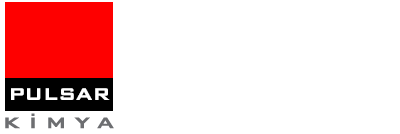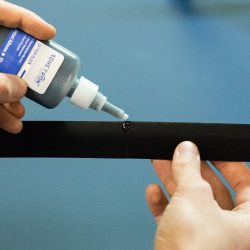What Is Super Glue Actually?
Cyanoacrylate adhesives, which we know as instant adhesives (super glue), are the general name given to one-component, solvent-free adhesives that dry in a very short time, have high heat resistance and penetration properties, and provide adhesion with a small amount of product. It is used with the abbreviation “CA” in the industry. It is used for bonding many different materials such as PVC, ABS, wood, metal, rubber, leather, cardboard, ceramics. Today, in addition to industrial use, cyanoacrylates are used in a different form in the medical field. “Ethyl-2 Cyanoacrylate” or “2-Octyl Cyanoacrylate” products are used in military operations where it is necessary to cut off the blood flow as soon as possible, especially in areas where tissues need to be joined quickly, such as cardiovascular surgery.
How Was Instant Adhesive Discovered?
The discovery of cyanoacrylate adhesives dates back to World War II. In this war, the German army adopted the basic attack doctrine called Blitzkreig or “Lightning War”. According to the “Lightning War”, the enemy would not be allowed to establish a fixed defense line with sudden and rapid attacks, and in this way, the enemy troops would be destroyed before they could make a full preparation. The most important elements in these attacks were armored ground vehicles such as Tanks and Panzers and mechanized infantry units. The sudden attacks of these troops combined with their high firepower made it very difficult for the allies to defend. The M1 Garand infantry rifle, which was used by the US army at that time, could not be very successful in these conflicts, despite its high accuracy rate, its inability to fire rapidly and its low bullet capacity. In order to reduce the impact of the enemy troops, the US army began to focus on solutions that would render them ineffective from long distances, and began to conduct research on attaching binoculars to rifles. In this way, it was aimed to reduce the effectiveness of fast troops by targeting vehicle commanders who had to lead the war from outside their armored vehicles, and to inflict more casualties on mechanized infantry units that could not show their success at close range at long distances.
 Harry Coover ve Fred Joyner
Harry Coover ve Fred Joyner
In the light of these studies, Harry Coover and Fred Joyner, who work as chemists at Eastman Kodak; formulated this product, which provides very fast adhesion with the surface it comes into contact with. Although the product could not get approval from the US army, Eastman Kodak company patented the product and when the years showed 1958, the first cyanoacrylate was launched under the name “Eastman 910 Super Glue”. To the side, one of the product’s inventors, Harry Coover, is seen in a product presentation where he is bonding glass, plastic, wood and paper.
“Eastman Kodak” company was the most advanced roll film producer of the time. In the 1950s, when digital recording was not yet possible, roll films produced by Kodak were used in cameras, camcorders and projectors. After the 2nd World War, the entertainment culture, which became widespread especially in the USA, increased the interest in Movie Theaters, and in this period, “Hollywood” started to attack in terms of production. The development of sound and color technology also meant that movies of the era were recorded on longer reels. As a result 400ft in a 90 minute movie. It had become a necessity to use a minimum of 3 film reels (121mt.). It was not an easy task for the machinist using the projection in the projection technology of the 1950s to make the transition between the rolls without being noticed by the audience. In the case of using “adhesive tape” to join the film rolls, the “magnetic sound lines” on the film strip were blocked and this was noticed by the audience. Also, the sticky tapes leaving residue on the projector parts could cause different mechanical problems in the long run. Such unfavorable situations led to the necessity of combining the film rolls with the “Splicing – End-to-end joining” method, and Harry Coover’s “Super Glue” invention came to the rescue here as well.
Where Does the Name Super Glue Come From?
Cyanoacrylates entered our country with the products of a Japanese company in the 1980s. At first, the distrust of Japanese products was replaced by Japanese companies, which are technology giants, with electronic products such as television, radio-tape, walkman, as well as Japanese branded watches and Japanese branded calculators supplied to government offices by the DMO office at that time. Similarly, the presence of the phrase “Made in Japan” on the product boxes and packages in addition to the Japanese writings on Japanese branded cyanoacrylate products has caused all cyanoacrylate products to be called “Japanese Adhesive”. Thanks to its ease of application, high holding power and ability to process many different materials, cyanoacrylates are still popular in many different areas from the manufacturing industry to small household repairs.
Pulsar Chemicals Cyanoacrylate Solutions
As Pulsar Kimya, we are able to offer tailor-made solutions for cyanoacrylate group products according to the material to be applied, surface properties and sectoral needs. In this context, it is medically approved for medical applications; in low viscosity, filler and/or flexible form for applications such as defense industry, automotive and electronic production; In the manufacturing industry, we have products for different needs, such as in gel form, to be able to apply on vertical surfaces. With our automatic dosing products, they can be easily used in mass production with the help of appropriate dispensers. It seems that cyanoacrylate products, which have been in our lives for nearly 60 years, will continue to be used for a longer period of time due to their properties.
Practical Information
Cyanoacrylate types and usage areas
| Methyl | Ethyl | Octyl | Butyl | Alkoxy | Methoxy | |
| ODOR | Very Strong | Medium | Low | Low | Very Low | Lowest |
| STRENGTH | Very Strong | Strong | Strong | Low | Low | Lowest |
| USE | Industrial | Industrial-Household | Medical (Surgical) | Medical (Cosmetic) | Medical | Medical |
Cyanoacrylate cleaning and removal methods
Skin and Fabric: Scraping or peeling is unfortunately not an effective method, such applications can damage your skin and fabric. Acetone is the most basic solvent of cyanoacrylate products. You can easily clean the skin and fabric by applying acetone to the relevant area. In areas where eyes, lips or skin can be easily irritated, the use of acetone may not be appropriate.
Glass Surfaces: Scraping on glass surfaces will cause scratches. You can apply solvents such as acetone, alcohol, hot water, baking soda on these surfaces. Scrubbing should not be done in baking soda application.
Metal Surfaces: Cleaning or dismantling can be done on metal surfaces by cleaning with acetone or by heating.
Plastic and Vinyl: Cleaning and dismantling of cyanoacrylate products from plastic and vinyl surfaces is more difficult than glass and metal surfaces. on these surfaces•
- Soak and soak in ammonia-free detergent water
- Acetone application (Testing on a small surface and observing whether it damages the material)
Nitronethane application: (Testing on a small surface and observing whether it damages the material)
Author: Kamil Ocak
Source
- https://www.compoundchem.com/2015/10/15/superglue/
- https://tr.wikipedia.org/wiki/Japon_yap%C4%B1%C5%9Ft%C4%B1r%C4%B1c%C4%B1s%C4%B1
- http://www.london-video-cine.co.uk/Cine-Film-Identification.html
- Turkish journal of Urolohy, 2017, Siyanoakrilik doku yapıştırıcıları: Biyokimyasal özellikleri ve ürolojide kullanımı, Sema Nur Ayyıldız1, Ali Ayyıldız2
- https://www.warhistoryonline.com/instant-articles/us-infantry-tactics-of-wwii.html#:~:text=The%20Americans%20had%20to%20rely,them%20with%20sufficient%20aerial%20support.
- https://smallwarsjournal.com/jrnl/art/evolution-of-the-sniper-rifle
- https://bilimgenc.tubitak.gov.tr/makale/japon-yapistirici-japon-degil-abdli
- https://nedir.ileilgili.org/siyanoakrilat#:~:text=Siyanoakrilat%2C%20end%C3%BCstriyel%20kullan%C4%B1mda%20genellikle%20CA%20olarak%20k%C4%B1salt%C4%B1l%C4%B1r.&text=Siyanoakrilat%2C%20Harry%20Wesley%20Coover%20Jr,yap%C4%B1%C5%9Fan%20bir%20form%C3%BCle%20rastlamas%C4%B1yla%20ke%C5%9Ffedilmi%C5%9Ftir

